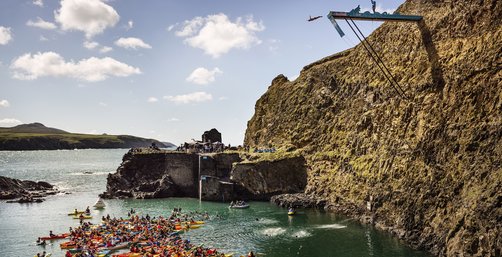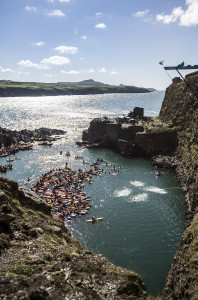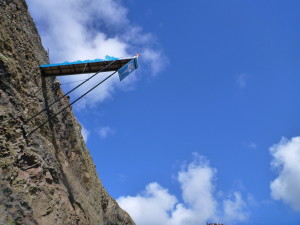News
Red Bull Cliff Diving World Series: Freediver Safety Perspective

[youtube id=”4iJsMFM_gcU” width=”100%” height=”350px”]
After a busy day preparing for a record attempt I trawled through my information stream of e-mails. In the Inbox was a welcome sight. The organiser of the safety crew for the Red Bull Cliff diving World Series had contacted me, asking if I was interested in doing the diving safety for the 2013 event in Abereiddy, South Wales at the Blue Lagoon. Information had already started to filter through to me about this event a few weeks before, and I had googled a previous year’s competition, and seen the location and the whole thing just looked stunning.
I duly accepted the role of being on the surface of the water as the athletes dived from the 27 metre high diving board. We were to follow the Divers down into the water and deal with the potential of unconsciousness or spinal injury or simply winding of the athlete. I might add at this point due to the nature of the set up, and the skill of the athletes, this is another example of an extreme sport where there are very few injuries. But like any sport, even the sports that on the surface look like there are small risks only, accidents can happen.
I was asked to take a second freediver with me for additional support that had the required abilities. Given it was a 4-5 day contract, and located down South, I chose my good friend Sam Still. We have entrusted our lives to each other on innumerable occasions as safety divers for our own sport for almost exactly a decade now. The team was coming together; in addition to us, there was a very experienced scuba diver to deal with the potential of a deep prolonged incident, a paramedic on a jet ski operated by a Jet ski rescue driver/instructor (in case a diver needed a quick transfer to shore), both of whom had done the previous year’s competition, and of course the organiser, who had the experience of last year’s event. We were part of an experienced team.
On the shore were advanced paramedics, coastguard, various methods of transferring casualties and plenty of medical equipment for all eventualities. My hats off to the Red Bull team – when they do something, they do it properly! No cutting corners, no expense spared in safety. An entire pontoon was set up to deal with an incident; it was never needed, but doesn’t detract from it being there.
Wednesday 11th September 2013: Set up
Thursday 12th September 2013: Training
Friday 13th September 2013: Qualifying dives
Saturday 14th September 2013: Competition Day
On the morning of the set up we travelled with the crew to the venue. We parked up right next to the sea, right on the South West Wales coast, a beautiful beach to launch the armada of craft that we would eventually take over the lagoon. We decided firstly to go and view the venue – what an amazing place. I travel all around the world and this is certainly a unique place. Like a Roman amphitheatre, with a deep water pool at the bottom, with access and egress only possible around and over steep cliffs or at high tide, you could take vessels of all sizes through the narrow entrance to the bottom of the amphitheatre.
Enough time already spent, it was the beginning of what turned out to be a 12 hour day. I put many of the skills I’d learned from my two decades on and around water to good use – drove RIBS, set up platforms, towed RIBs, kayaked, tied knots, made shot lines, made buoyed off areas, depth sounded the entry points and many more useful jobs.
On training day we were fortunate to have experienced cliff diver Joey Zuber, now a TV presenter, organiser and motivational speaker. The training consisted of lots of descriptions of how the cliff divers dive, how they may spin, how far away they would land and what was the most likely outcome of a bad dive etc… He also told us about his worst accident where he smashed his femur; what made matters worse was his location in a remote part of Columbia, but that is another whole story in itself.
We learnt that the stream of water that was at the bottom of the cliff was actually so the athletes can judge where the water is to perfect their landing, so we took that job very seriously. We did get ribbed by some of my students who had travelled to see the show that we were just the ‘splashers’.
The Underwater spinal position they wanted to put the divers in was very similar to our normal lifting procedure, once we had ‘got our eye in’ on how deep and at what speed the athletes got to that depth we could pinpoint every single time in the bad visibility water (maybe 2 metres?) where to be. We decided I’d go shallow and quick, so maybe to 2 metres each dive, and Sam would go below the plume of water the diver produced and get any deeper problems, maybe 4 metres. I was extremely surprised how shallow the athletes went even on perfect dives; they were coming up in a couple, few seconds nearly every time.
We practised the transition for getting an injury from the original underwater rescue to shore. A single Freediver lifts the Cliff Diver to the surface and stabilises with Scuba diver to assist in positive buoyancy. The other Freediver gets the spinal board from the Jet Ski and positions it under the diver. Once the diver is on the board it is slid onto the back of Jet Ski, which then travels to shore, maybe 50 metres away. We got the victim from being underwater to being on the shore with the larger group of Paramedics literally within 20 seconds. It was slick! This gave us great confidence that the job in hand was within our capabilities.
The real test started once the athletes started their warm up dives. More than once, there was a stream of Cliff Divers leap from the 27m platform, one after another. We literally power dived down for the first, swam to the surface, checked they were okay and on the Jet Ski they went back to shore. As soon as we then look up to the platform the next diver was there ready to soar through the air into the water. So with no time to hang about we would swim quickly back to our set positions, where the Cliff Divers would occasionally gave us specific instructions at to where they wanted us, as each had their own preference near or far. Once they were happy we would all signal that were ready and then we started to splash hard to make their entry visible. They’d take some steps back, stretch, then they’d walk forward and dive, we’d start to breath in as they left the platform and as soon as they hit the water, about 3 seconds later, we would hold our breath and dive after them, swimming frantically over to them, follow them up, see they are okay, lie on our back to signal to the next cliff diver….
It was one of those repetitive series of actions where you can just forget about everything in the world except your specific reason for being there. The brief times of rest in between I would lie on my back, watching a cliff diver walk over to the edge of the platform, then watching the clouds in the blue sky behind the diver’s silhouette as they slowly drifted behind the cliffs, the warm sun on my face… and then they’d jump, everything would start to go into slow motion as I got more into the zone… nice.
The divers came quick because the water was cold and they wanted to get back into the hot tub. South Wales, even in August, in just a tiny pair of speedos is only for the hardy.
The competition day came soon enough. We had met the athletes a few times over lunches and dinners and they are a sound bunch, genuinely great people; we knew we had to be there for them. An armada of kayaks and boats started to filter through into the lagoon and find their spot. Hundreds of spectators lined the cliffs, the water’s edge and some even in the water. The amphitheatre was full, full of excited viewers and the athletes never failed to impress.
Find out more about the Red Bull Cliff Diving World Series here
News
Book Review: Fire on Monroe Bravo by Fred Lockwood

Fire on Monroe Bravo is the latest book in the Jack Collier series by Fred Lockwood. Our story begins with our lead characters, Jack and Sandro, owners of Marine Salvage & Investigation Company, arriving on the Monroe Bravo Oil & Gas Platform in the North Sea. Having secured a contract for their vessel the MV Stavanger to act as support ship to the platform for TransGlobal Oil, our protagonists are on a celebratory visit.
However almost as soon as they arrive a series of explosions rock the platform, causing huge damage, loss of life and the very real danger of a massive human, ecological and financial disaster.

As the danger mounts for both our heroes and the surviving workers, Jack and Sandro will have to escape the inferno, all while trying to save the platform and the men still trapped unable to help themselves.
The disaster sets the scene for the unfolding story lines following the fate of the platform and our main characters, the police investigation into a suspected terrorist act and the actions of TransGlobal Oil as they attempt to navigate the pubic outcry and financial repercussions.
In his eighth book, Fire on Monroe Bravo, Fred Lockwood delivers an explosive thriller, with plenty of above and in-water drama, and our heroes fighting for survival, what more can you ask for?
We thoroughly recommend this read and look forward to the next in the series. For more information about his book series, you can check out the reviews of his previous books here on Scubaverse.
- Title: Fire On Monroe Bravo
- Author: Fred Lockwood
- ISBN: 979-8325324536
Available in a paperback version and for Kindle from Amazon and book stores.
Blogs
Alonissos: The complete diving destination (Part 1)

In June we were incredibly fortunate to be invited to dive in Alonissos, a small Greek Island in the Sporades island chain located in the North Aegean Sea. While I have long been a big fan of the Greek Islands as a great holiday destination, I had not had the opportunity to do any diving on previous visits and Mike and I were extremely excited to see what Alonissos had to offer both above and below the surface!

The Sporades are easily accessible via the airport in Skiathos (the first island in the chain), which is served by Jet2 flights from all major UK airports from May through October. Numerous ferries and charter boats make island hopping from Skiathos Town a breeze. After an hour boat ride, the picturesque port of Patitiri was a wonderful introduction to Alonissos, where we were met by our gracious hosts Kostas of Albedo Travel and Dias of Alonissos Triton Dive Center. Mike and I were delighted to be staying at the Paradise Hotel, aptly named for its stunning views over the sea and great location for walking to the waterfront.

Alonissos is beautifully situated in the National Marine Park of Alonissos and the Northern Sporades, the largest marine protected area in Europe. The surrounding seas offer fabulous marine life, including incredibly rare species such as the Mediterranean monk seal. They boast deep walls covered in gorgonians and sponges, stunning topography with caverns, swimthroughs and pinnacles, and the first accessible ancient shipwreck from 500BC!

In locations where historical sites have been reported, the waters are largely restricted, but with collaboration between government, underwater archeologists and dive centres, incredible underwater museums are being created for a truly unique diving experience. Alonissos is home to the first of these, the Ancient Shipwreck of Peristera Accessible Underwater Archeological Site. The chance to dive into history (along with reports of healthy reef life and amazing underwater topography) meant Mike and I were keen to get in the water.

Our introduction to the diving around Alonissos was at the Agios Georgios Pinnacles, in the channel between Alonissos and Skopelos. This fantastic site was named “The Chimney,’ and proved to have a huge amount to see. We got to a decent depth here (over 25m), and marvelled at a colourful reef wall with a wonderful swim through whose rocky walls were absolutely covered with life. As well as brilliant topography there was no shortage of macro life here. We saw numerous nudibranchs, five different species in total. The second dive at Mourtias reef nearby was a shallower dive along a nice wall with lots of crevices. Several moray eels and grouper called this site home. We enjoyed looking in the crevices for lobster and smaller benthic life, such as cup corals and tunicates.

Our itinerary allowed us two dives a day with afternoons left to explore the island with our hire car and evenings to enjoy the famous Greek hospitality. This proved to be a lovely mix of in-water and land based diversions.

The next days diving to the Gorgonian Gardens and Triton’s Cave was to be even better! These two stunning sites are nothing short of fabulous. The Gorgonian Gardens was a deep wall near to the Agios Georgios islands. The ever-present currents in this deep channel meant that the sea life was amazing … the namesake Gorgonian sea fans dotted the wall at a depth of 30 to 50 meters, getting ever larger the deeper we went. Above 30m was by no means less beautiful, with sponges, corals, scorpionfish, moray eels and some rare and colourful nudibranchs.

The second shallower dive of the day was to Triton’s Cave or the Cavern of Skopelos, on the east side of that island. The spectacular rock formations had wild striations both above and below the water making a truly epic topography. The cavern entrance was at 14m, and big enough for a buddy pair, winding up to 6m and passing two beautiful windows out into the blue. Emerging from the cavern, the light at the shallower depths and the incredible rock formations made for a fantastic gentle swimming safety stop and we all surfaced by the boat with massive grins.

Check out our next blog :Alonissos: The complete diving destination (Part 2)” to hear about our amazing dive on the 2500 year old Peristera Wreck!
Thanks to:
Alonissos Triton Dive Center https://bestdivingingreece.com/
Albedo Travel https://alonissosholidays.com/activities/
Paradise Hotel https://paradise-hotel.gr/
Alonissos Municipality https://alonissos.gr/en/
-

 Blogs2 months ago
Blogs2 months agoDiving With… Nico, Ocean Earth Travels, Indonesia
-

 News1 month ago
News1 month agoMurex Bangka Announce New Oceanfront Cottages & Beachfront Dining
-

 Blogs2 months ago
Blogs2 months agoA new idea in freediving from RAID
-

 Marine Life & Conservation1 month ago
Marine Life & Conservation1 month agoIceland issue millionaire whale hunter a licence to murder 128 vulnerable fin whales
-

 Marine Life & Conservation2 months ago
Marine Life & Conservation2 months agoThe Shark Trust Great Shark Snapshot is back
-

 News3 months ago
News3 months agoCharting New Waters; NovoScuba Goes Global with the Launch of their Revolutionary Dive Training Agency!
-

 Gear News1 month ago
Gear News1 month agoNew Suunto Ocean – a dive computer and GPS sports watch in one for adventures below and above the surface
-

 Marine Life & Conservation Blogs2 months ago
Marine Life & Conservation Blogs2 months agoBook Review: Plankton

















